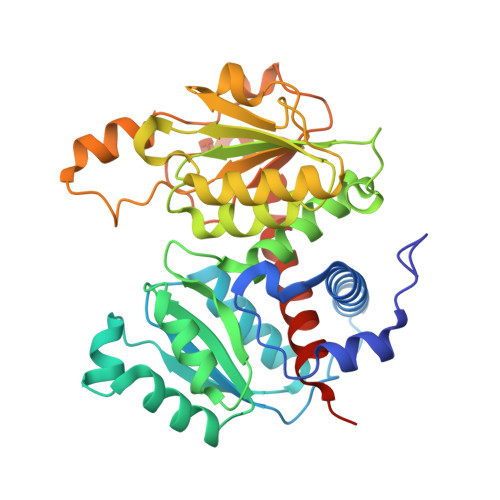Molecular Target Validation of Aspartate Transcarbamoylase fromPlasmodium falciparumby Torin 2.
Bosch, S.S., Lunev, S., Batista, F.A., Linzke, M., Kronenberger, T., Domling, A.S.S., Groves, M.R., Wrenger, C.(2020) ACS Infect Dis 6: 986-999
- PubMed: 32129597
- DOI: https://doi.org/10.1021/acsinfecdis.9b00411
- Primary Citation of Related Structures:
6HL7 - PubMed Abstract:
Malaria is a tropical disease that kills about half a million people around the world annually. Enzymatic reactions within pyrimidine biosynthesis have been proven to be essential for Plasmodium proliferation. Here we report on the essentiality of the second enzymatic step of the pyrimidine biosynthesis pathway, catalyzed by aspartate transcarbamoylase (ATC). Crystallization experiments using a double mutant of Plasmodium falciparum ATC ( Pf ATC) revealed the importance of the mutated residues for enzyme catalysis. Subsequently, this mutant was employed in protein interference assays (PIAs), which resulted in inhibition of parasite proliferation when parasites transfected with the double mutant were cultivated in medium lacking an excess of nutrients, including aspartate. Addition of 5 or 10 mg/L of aspartate to the minimal medium restored the parasites' normal growth rate. In vitro and whole-cell assays in the presence of the compound Torin 2 showed inhibition of specific activity and parasite growth, respectively. In silico analyses revealed the potential binding mode of Torin 2 to Pf ATC. Furthermore, a transgenic ATC-overexpressing cell line exhibited a 10-fold increased tolerance to Torin 2 compared with control cultures. Taken together, our results confirm the antimalarial activity of Torin 2, suggesting Pf ATC as a target of this drug and a promising target for the development of novel antimalarials.
- Unit for Drug Discovery, Department of Parasitology, Institute of Biomedical Sciences, University of São Paulo, Avenida Professor Lineu Prestes 1374, 05508-000 São Paulo-SP, Brazil.
Organizational Affiliation:

















